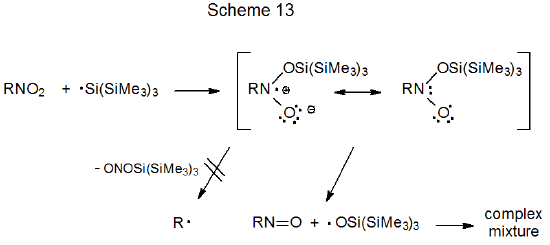V. Reactions of Nitro Compounds with Silanes
- Page ID
- 24088
Concerns with the toxicity of tri-n-butyltin hydride and the purification problems that accompany its use have spawned a variety of attempts to replace this reagent with a less troublesome one (see Appendix I). Tris(trimethylsilyl)silane normally is an attractive alternative to Bu3SnH, but it fails completely in this role in group replacement reactions in nitro compounds. The reason for failure is that the radical formed by addition of (Me3Si)3Si· to a nitro group does not break the carbon–nitrogen bond required for group replacement but rather cleaves a nitrogen–oxygen bond to begin a sequence of reactions leading to a complex reaction mixture (Scheme 13).48

A more effective procedure for reducing the amount of tri-n-butyltin hydride needed for nitro-group replacement with a hydrogen atom consists of regenerating Bu3SnH from the Bu3SnNO2 formed during the substitution process. A pair of reactions that achieve group replacement and regenerate Bu3SnH are given in equations 11 and 12. This alternative method requires only 10% of the tri-n-butyltin hydride needed in the standard procedure.49
.png?revision=1&size=bestfit&width=350&height=24)
.png?revision=1&size=bestfit&width=400&height=25)

